#Fertilizers & Nutrients
Photo

#weedmaps#Indica#hemp smoking#Fertilizers & Nutrients#marijuana news#marijuanaplants#ganjababe#legalizepot#gethighwithme#cannabisfact
537 notes
·
View notes
Text

"Salmon Run"
Is she bringing the salmon up the bank to fertilize the trees, or to eat it? Why not both? 🐟🌲
12"x16" acrylic on reclaimed support
#art#traditional art#coyote#acrylic#painting#animal art#primitive wiggles#naive art#anthropomorphic#salmon#pnw#ecosystem#fertilizer#cycle of nutrients#circle of life#fishmeal
205 notes
·
View notes
Text
I like to imagine that Phoenixes are not birds but in fact Pyrophilic Plants that convergently evolved to take Avian form. They hold their seed within their body and the fiery end of the old Phoenix provides the trigger for the new one to germinate (producing a nice fertile bed of ash in the process)
#not that ash is always good for fertility in every circumstance due to it's high ph#but it provides a ready source of nutrients and pyrophilic plants tend to be (unsurprisingly) well adapted to its presence
20 notes
·
View notes
Text
one thing about me is when i miss a racing event i will go completely off grid until i can watch it in full bc being spoilered makes me insane in the membrane literally if u reveal the weather conditions i will go full joker mode so my friends umprompted have started sending me charles leclerc instagram updates with the captions scribbled out like feeding a wild fucking animal through the bars of its enclosure . real recognises real

#jealous bc ur habitat is not stable nor nutrient rich NOR populated with a plethora of highly fertile bitches bitches ?#hmm! not a problem i have per say……..
13 notes
·
View notes
Note
Then you do not know the core principle of veganism, which is animal suffering, welfare and rights. Animals are considered individuals under veganism and that's why a killing of an animal is compared to murder and forced artificial insemination by humans is compared to rape.
Veganism, although there are different fractions, is not advocacy for more ethical animal consumption because that would be like advocating for more ethical murder which is a contradition. That's why vegans get so heated about it and throw insults. Hope that makes sense.
Veganism wants to find a way where killing animals for nutrients will not be necessary anymore.
cool man 👍 how does that ideology include indigenous people who have been using animal products sustainably for hundreds of years
#and sorry i’m just never going to see it that way. it’s a fearmongery stretch at best#vegan discourse#also: would you eat an egg if it was produced locally? never would have been a baby chick bc chickens make way more eggs than they fertilize#it’s Just Nutrients#do you have beef (lol) with wolves and bears? why are they any different from a human eating meat to survive#cricket answers
16 notes
·
View notes
Note
How much faster will the plants grow after I buy this potion? Will I need to give the plants more nutrients?
"No, you won't. This potion speeds the process up by 10 times!"

#basils plants & potions#basils plants and potions#basil's plants & potions#ofa#omori food administration#using nutrients rich soil and fertilizers and a but of alchemic touch plants will gro faster but maybe not as strong
2 notes
·
View notes
Photo

Starting A Successful Garden From Scratch
Vertical gardening techniques are a great way to maximize the area in your garden, especially if you have limited space. By planting shrubs vertically, you can increase the number of plants you can grow in a small area. You can use trellises, stakes, and other supports to grow climbing plants which can add more dimension to your backyard and create a more private and intimate area.
#garden#exterior#climate#fruit#yard#fertilizers#nutrients#chemical#organic#laying garden turf#soil conditions#chemicalfertilizers#organic fertilizers
3 notes
·
View notes
Note
Come to think of it, you being a flower implies that at one point you were fed compost or fertilizer, meaning you now live with the knowledge that you ate crap and rotten plants as a seedling but you weren't sentient at the time.
Have a nice day!.


*Thanks, Benny.*
8/10 - t-pose
#undertale#art#flowey#small artist#undertale art#paper art#ask flowey#undertale fanart#ask blog#ask undertale#papyrus#ask papyrus#funny#friend!!!#benny-the-grinning-fish#flower food#fertilizer#and he still takes nutrients from soil to this day#disgustinf#M!A#t pose
10 notes
·
View notes
Text
life hack: forget to prep the name of the country your pcs are in, pull something off the top of your head, realize it is actually a spell, go ha ha wizards are fucking things up, and improvise your ass off until youve actually developed something narratively interesting for your world
#the wizards made a floating city and it does have lots of panels of glass so the sun (which hates the earth) can continue to shoot fire down#the sun hates the world because it got snagged in from the dimension of fire and so now every day at noon it blasts rays of fire#also it does help with fertilizer and getting nutrients to the plants so thats good <3#also the reason the wizards floating city doesnt stay in one place to protect villagers below is because wizards are ASSHOLES#the only thing i had prepped was that the sun shot fire downwards sometimes#everything else i just went **uhhhhhhh implications okay**#im having so much fun alsdkjf#the wizard floating city is named feather fall#i really like my players theyre great and good to rp with#also i got to be a weird little goblin named bartleby grimehands who is a tinkerer from a long line of tinkerers#he has the best voice to do and it did turn a bit doofenschmirtz which was a delight#also shoutout to zip nee grimehands because i did snag that url as a name because it has good vibes alsdkfj#todays session was good :]
12 notes
·
View notes
Text
A lil garden update!
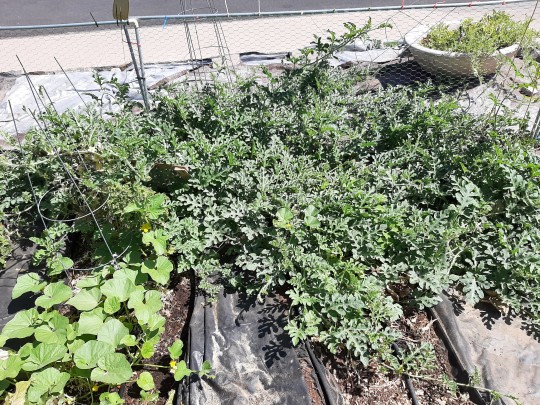
This is my watermelon and armenian cucumber patch, I totally forgot exactly how much both these plants give ground cover. This was probably two weeks ago, it's doubled since.
It's also got melons growing!!
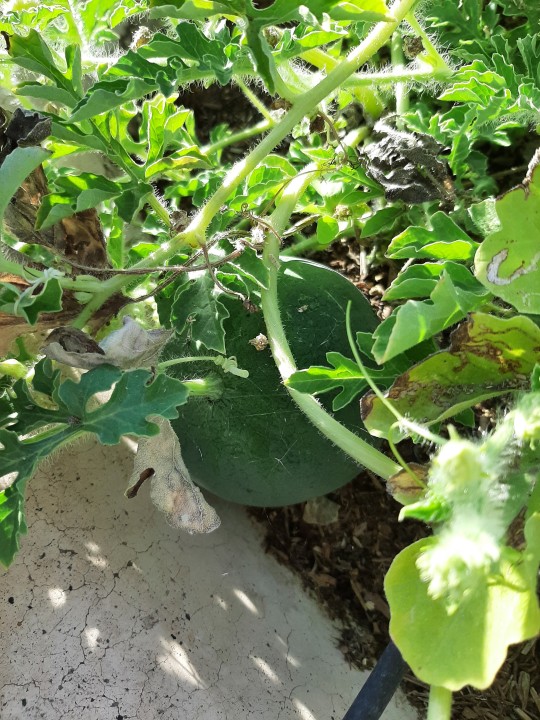
Like this lil one! Honestly I planted probably 4 varieties. A large melon, some cantaloupe, honeydew and some personal melons. I'm not entirely sure what all has sprouted and grown but whatever grows we'll be saving the seed :)
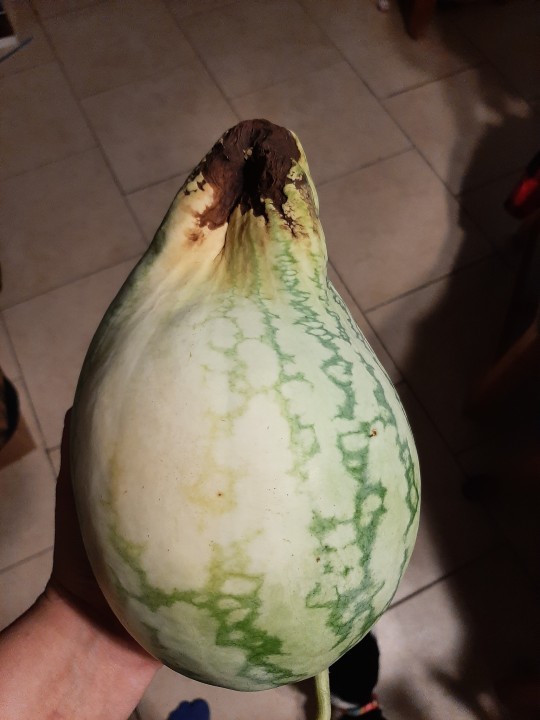
I had to pick one of the melons, see that black stuff on the end? It's likely blossom end rot.
What causes blossom end rot? Its usually a lack of calcium. But it can also be caused by not having a regular watering schedule (which to be fair could be so. I haven't been good with my morning watering schedule due to some stuff happening. But they currently get 30 minutes minimal daily. And soil looks good on moisture content.)
Either way, if it's a watering issue then the solution might be as easy as setting up a regular auto watering cycle. I'm leaning more towards it being calcium problems currently though as I haven't refreshed the manure/compost this season yet and where I'm at fertilizing twice a year is highly suggested.
When you find blossom end rot it's best to remove all the damaged fruit as early as possible. While doing that check your soil medium. Is it soggy or have a lot of water retention? Then you've got waaay too much water. The soil should be moist but not soggy and it's a good idea to be sure the vines and fruit are not in standing water. Some folks like to make mounds like with pumpkins and plant their melons in the center so water flows down and out. If you can't do that see about putting a net or trellis out to keep your melons and vines off the ground (melons do great trellising upwards too! Be sure to use scrap fabric or pantyhose to keep your melons supported.) If it's good moisture chances are it's a nutrient problem.
For me I think it's a nutrient problem, so I'm trying out a method of calcium amending to see if it helps. A good way to avoid it is to seed start your melons (I direct seeded this year so I could not take my own advice lol) when it's time to transplant take a handful of tums, crush em up and put a bit of the powder in the bottom of each hole you dig and then place your transplant inside. Water and let it grow.
☆☆☆☆EDIT TO ADD!!!! ☆☆☆☆
I can not at this time suggest or endorse using tums for calcium purposes, I want to do some experiments with this. I'm not sure if I used too much calcium or if something else happened but the day after I poured my calcium water in the garden almost all of my calcium plants seemed to wither up. I am off to check them today now to see if they are still looking not great. If so they will be pulled and another update to come later.
☆☆☆☆☆end of edit☆☆☆☆
Since I direct seeded I can't exactly do that, so I just took some tums, crushed em to a fine powder. Mixed it with water and poured this water around the base of my melon plants. I'll do this again in a few days probably about 3 times? I'm kinda guessing at the moment. 🤷♀️ but that's part of the fun of farming, gardening and homesteading is figuring out what works best.

Btw this is what the inside looked like of that blossom rot melon, it didn't get wasted either, the chickens are digging this produce as a nice cool treat~
🌱🍉 Happy Homesteading and Gardening!! 🍉🌱
#homesteading#self sufficiency#self sufficient living#studentfarmer#thestudentfarmer#food#farming#garden#gardening#low waste#watermelon#fertilizer#nutrients#garden tips
16 notes
·
View notes
Text

this is the most I’ve ever made
even with the additional money made from the branch 😭
#dave the diver#i know about the best dishes but upgrades in this game are fuckin expensive#especially with the farm for other foods (having to pay for that stupid nutrient fertilizer is annoying)#I might be crazy waiting until chapter 6 to finally start the dredge dlc but#I rather dredge for materials than gamble in the sea people village lol
1 note
·
View note
Photo

#bud#reefer#girlswhosmokeweed#blunt#weedstagram#ogkush#mmjmovement#Fertilizers & Nutrients#grow#strain
2 notes
·
View notes
Text
How Organic Nutrients Enhance Plant Growth and Health

Gardening enthusiasts and farmers alike are increasingly turning to organic fertilizers to nurture their plants and crops. Unlike conventional fertilizers, which often contain synthetic chemicals, organic fertilizers harness the power of natural ingredients to provide essential nutrients to plants. These nutrients are derived from organic sources such as compost, animal manure, and plant residues. By opting for organic nutrients for plants, growers can enhance not only the health of their crops but also the overall sustainability of their farming practices.
Promoting Plant Health with Organic Nutrients
Unlike synthetic fertilizers, which may contain harsh chemicals that can harm beneficial soil organisms, organic fertilizers nourish the soil and create a thriving ecosystem for plants. One of the primary benefits of using organic fertilizer is its ability to promote the health of plants. The nutrients are released slowly, providing a steady supply of nourishment to plants over time. This helps to strengthen the plants' immune systems, making them more resistant to pests and diseases.
Enhancing Soil Quality for Sustainable Growth
In addition to promoting plant health, organic fertilizers also improve soil quality. Organic matter in organic fertilizers helps to improve soil structure, making it more porous and better able to retain moisture. This not only reduces the need for irrigation but also prevents soil erosion and nutrient runoff. Furthermore, the organic matter in organic fertilizers acts as food for beneficial microorganisms in the soil, promoting their growth and activity. This, in turn, enhances nutrient cycling and makes essential nutrients more readily available to plants.
Maximizing Crop Yield and Quality
By providing plants with a balanced and diverse array of nutrients, organic fertilizers can significantly improve crop yield and quality. Unlike synthetic fertilizers, which may contain high levels of nitrogen or phosphorus, organic fertilizers contain a more balanced mix of nutrients that are tailored to the needs of plants. This helps to prevent nutrient imbalances and deficiencies, ensuring that plants have everything they need to thrive. As a result, growers can enjoy higher yields of healthier, more flavorful crops.
Conclusion:
From promoting plant health and enhancing soil quality to maximizing crop yield and quality, organic nutrients for plants offer a holistic approach to farming that is both effective and sustainable. By harnessing the power of natural ingredients, growers can nourish their crops while protecting the environment for future generations.
For more information on organic fertilizers and sustainable agricultural solutions, visit Fitochem.
0 notes
Text
Maximizing Growth Potential: Fertilizers for Every Crop and Climate
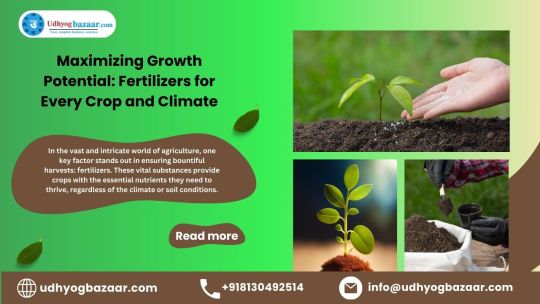
Introduction
In the vast and intricate world of agriculture, one key factor stands out in ensuring bountiful harvests: fertilizers. These vital substances provide crops with the essential nutrients they need to thrive, regardless of the climate or soil conditions. In this blog post, we'll explore how crop-specific fertilizers and nutrient-rich soil solutions play a crucial role in maximizing growth potential across various crops and climates.
Crop-specific fertilizers are tailored to meet the unique nutritional needs of different types of crops. From nitrogen-rich formulas for leafy greens to phosphorus-heavy blends for root vegetables, these fertilizers provide targeted support to enhance plant growth and yield. By supplying crops with the specific nutrients they require at each stage of development, crop-specific fertilizers help optimize productivity and quality.
One of the key benefits of using crop-specific fertilizers is their ability to address nutrient deficiencies commonly found in specific crops. For example, tomatoes may require extra potassium for fruit development, while corn might benefit from additional nitrogen for stalk growth. By understanding the nutritional requirements of each crop, farmers can select the appropriate fertilizers to ensure optimal growth and health.
Nutrient-rich soil solutions also play a crucial role in supporting plant growth and productivity. Healthy soil is the foundation of successful agriculture, providing plants with essential nutrients, water, and support. Nutrient-rich soil solutions, such as organic matter and microbial additives, help improve soil fertility, structure, and moisture retention, creating an optimal environment for plant growth.
Organic matter, such as compost and manure, enriches the soil with essential nutrients and enhances its ability to hold moisture and support beneficial microbial activity. Incorporating organic matter into the soil not only provides plants with vital nutrients but also improves soil structure, drainage, and aeration, promoting healthy root development and nutrient uptake.
Microbial additives, such as beneficial bacteria and fungi, contribute to soil health by enhancing nutrient cycling, suppressing harmful pathogens, and improving plant resilience to stress. These microorganisms form symbiotic relationships with plant roots, facilitating the uptake of nutrients and water and promoting overall plant growth and health.
Incorporating crop-specific fertilizers and nutrient-rich soil solutions into agricultural practices is essential for maximizing growth potential and ensuring sustainable crop production. By providing crops with the right nutrients in the right amounts, farmers can optimize yield, quality, and resilience while minimizing environmental impacts.
Conclusion
In conclusion, crop-specific fertilizers and nutrient-rich soil solutions are invaluable tools for maximizing growth potential in agriculture. By understanding the unique nutritional needs of different crops and implementing sustainable soil management practices, farmers can enhance productivity, profitability, and environmental stewardship. Whether you're growing leafy greens in a temperate climate or cultivating root vegetables in a tropical region, choosing the right fertilizers and soil amendments is key to unlocking the full potential of your crops and land.
0 notes
Text
What plants can be grown hydroponically?

In the world of modern agriculture, hydroponic gardening has emerged as a revolutionary method of cultivating plants without soil, using nutrient-rich water solutions. This innovative approach offers numerous advantages, including efficient resource utilization, faster growth rates, and the ability to grow crops in environments where traditional farming may not be feasible. Among the myriad of plants that can thrive in hydroponic systems, some stand out for their adaptability and productivity.
Leafy Greens: Lettuce, spinach, kale, and other leafy greens are some of the most popular choices for hydroponic cultivation. They have shallow root systems and high water requirements, making them perfectly suited for nutrient-rich water environments. With the right hydroponic setup, these greens can be grown year-round, providing a consistent supply of fresh produce.
Herbs: Basil, cilantro, mint, and parsley are excellent candidates for hydroponic growth. These aromatic herbs flourish in controlled hydroponic environments, offering superior flavor and quality compared to their soil-grown counterparts. Hydroponic herb gardens are ideal for culinary enthusiasts seeking a convenient and sustainable source of fresh herbs.
Tomatoes: Tomatoes are another popular choice for hydroponic cultivation. They thrive in nutrient-rich solutions and benefit from the support of trellises or vertical systems. Hydroponically grown tomatoes often exhibit enhanced flavor and texture, making them a favorite among home gardeners and commercial growers alike.
Cucumbers: Cucumbers are well-suited for best hydroponic systems, particularly when grown vertically to maximize space efficiency. With proper support structures and nutrient delivery, hydroponic cucumbers can produce abundant yields of crisp, flavorful fruits throughout the growing season.
Peppers: Bell peppers, chili peppers, and other varieties can thrive in hydroponic environments. These plants require consistent moisture and nutrient levels, which can be easily maintained in hydroponic systems. With proper care, hydroponically grown peppers can yield bountiful harvests of vibrant, flavorful fruits.
Strawberries: Hydroponic strawberry production has gained popularity in recent years due to its ability to maximize space and optimize growing conditions. By utilizing vertical towers or hanging systems, growers can cultivate strawberries without soil, leading to cleaner, healthier fruits and increased yields.
Microgreens: Microgreens are young, tender greens harvested at an early stage of growth. They are packed with nutrients and flavor, making them a popular choice for salads, sandwiches, and garnishes. Hydroponic systems offer an efficient means of producing high-quality microgreens year-round, providing chefs and home cooks with a continuous supply of fresh, nutritious greens.
Potatoes: While traditionally grown in soil, potatoes can also be cultivated hydroponically, especially in potato vertical farming systems. With proper tuber support and nutrient delivery, hydroponic potatoes can yield impressive harvests in a fraction of the space required for conventional soil cultivation. Vertical farming techniques optimize space utilization, making them ideal for urban agriculture and limited land environments.
When it comes to choosing the best hydroponics system for growing these plants, several factors should be considered, including available space, budget, and desired crop varieties. Vertical farming systems, such as tower gardens or vertical hydroponic racks, offer an efficient solution for maximizing space and increasing yields. These systems allow growers to stack multiple layers of plants vertically, optimizing space utilization and productivity.
Hydroponic gardening offers a versatile and sustainable approach to cultivating a wide range of plants, from leafy greens and herbs to tomatoes, cucumbers, and even potatoes. By harnessing the power of nutrient-rich water solutions and innovative growing techniques like vertical farming, growers can achieve impressive yields of high-quality produce year-round. Whether for commercial farming operations or home gardening enthusiasts, hydroponics represents a promising frontier in modern agriculture, paving the way for increased food security and environmental sustainability.
#hydroponic gardening#hydroponic plant growth#hydroponic syteam#hydroponic plant#hydroponics store near me#vertical hydroponic garden#hydroponic garden tower#hydroponic tower garden#hydroponic lettuce#hydroponic tomatoes#hydroponic seeds#hydroponics tower#aquaponics vs hydroponics#general hydroponics#hydroponic planter#hydroponic nutrients#hydroponic weed#hydroponics for weed#hydroponic strawberries#hydroponic fertilizer
0 notes
Text
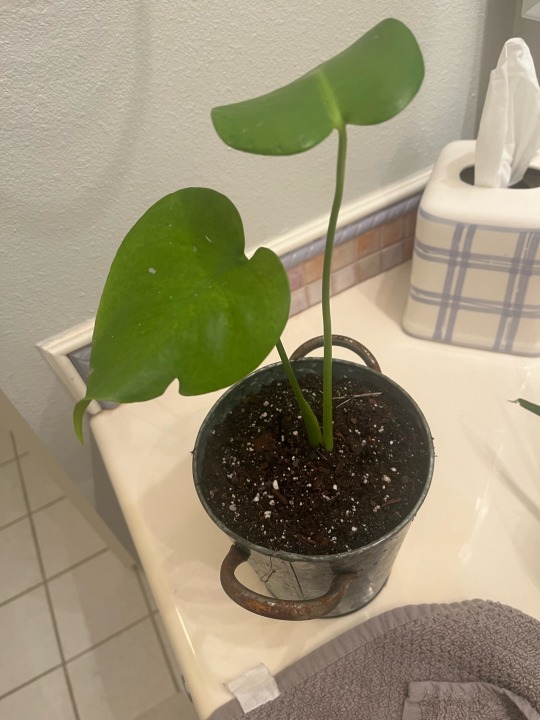
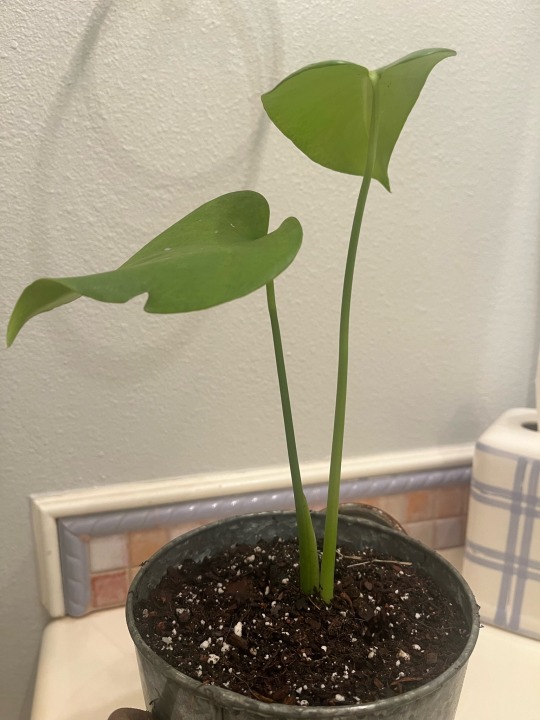
My monstera cutting has a home! We’ll see how it does.
#I’m curious. I hope I haven’t potted it too early but it’s color has gotten a bit dimmed the last couple of days#and it has two of the main root things. I’m just waiting on small roots. so I hate to leave it in water with no fertilizer if it has two#roots that can draw nutrients
0 notes